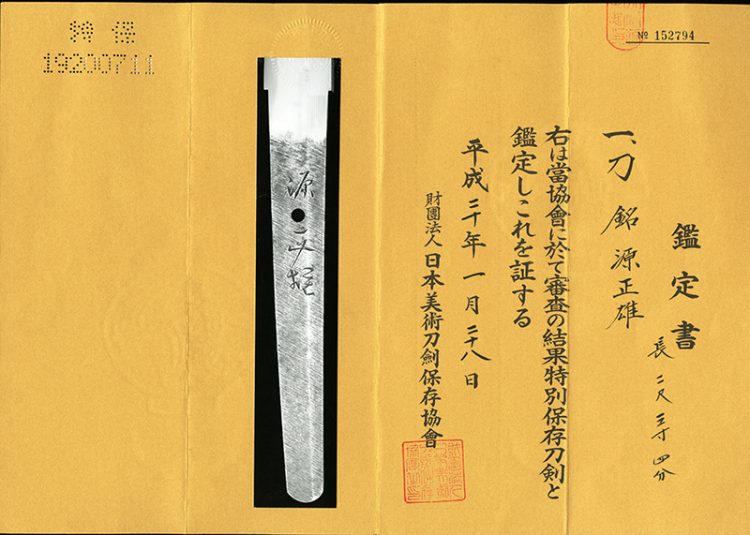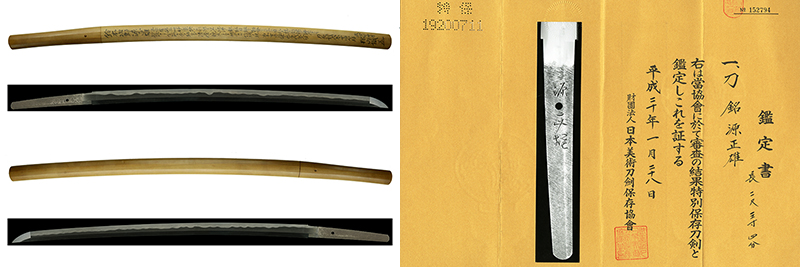説明
「刀姿 sword figure」
鎬造り庵棟、身幅やや太く重尋常、鳥居反り中鋒が延びる。茎は生で筋違い鑢がかかり、茎尻は栗尻。
「地鉄 jigane」
地鉄は小板目肌が良く詰み、板目、小板目が交じり、地沸微塵に厚くつき、地景細かく頻りに入り、鉄明るく冴える。
「刃紋 hamon」
刃紋は、大互の目乱れ、刃縁沸深く明るく冴え、銀筋・砂流しが頻りにかかり、刃中は葉が入り、金筋栄んに働く。釯子は乱れ込み履き掛け小丸に返る。
「特徴 detailed」
源正雄(鈴木次郎源正雄)は、幕末の名匠である源清麿の高弟として知られる刀工です。清麿の門弟の中でも、最も師に近い技量を持つ名手と評されており、清麿門下随一の実力を誇ります。「正雄」と銘を切ることから、清麿が「正行」を名乗っていた時代からの弟子であると推測され、一門の古参者であったと考えられます。
嘉永六年(1853年)に独立し、江戸下谷御徒町に居住しました。その作風は師である清麿の流れを受け継ぎつつも、互の目の腰が低い点に独自の特色があります。また、銘は流麗な草書体で巧みに彫られています。
本作は、豪壮な刀姿を持つ見事な一振りです。小板目肌が良く詰んだ地鉄に、大互の目乱れの刃文を焼き上げています。刃縁には深い沸が鮮明で明るく冴え、銀筋(稲妻)や砂流しが頻繁にかかり、刃中には足が入り、栄える金筋が見事に働いています。その卓越した技術がうかがえる素晴らしい作品です。
Masao Minamoto (Suzuki Jiro Minamoto Masao) was a prominent disciple of the renowned late Edo-period master Minamoto Kiyomaro. Among Kiyomaro’s students, Masao was regarded as the most skilled and closest to his teacher in terms of mastery. The fact that he signed his works as “Masao” suggests he may have been a disciple since the time when Kiyomaro used the name “Masayuki,” indicating that Masao was likely one of the senior members of the Kiyomaro school.
In 1853 (Kaei 6), Masao became independent and lived in Edo’s Shitaya Okachimachi district. His style followed that of his master, but with a distinctive characteristic of lower gunome valleys. His signature was skillfully inscribed in a flowing cursive script.
This piece is a magnificent blade with a grand and imposing appearance. It features a tightly forged ko-itame hada (small wood grain pattern) and a hamon of large gunome-midare (irregular clove pattern). The blade’s edge is deeply covered in bright and vivid nie (crystalline structures), with frequent inazuma (lightning-like lines) and sunagashi (streaks of martensite) throughout. Additionally, the hamon is adorned with frequent ashi (downward lines) and prominent kinsuji (golden streaks), showcasing extraordinary craftsmanship.
「拵 Koshirae」
ハバキ(habaki) :素銅地金着一重。
鞘(Saya) :白鞘。
「刀剣の状態 condition of blade」
研:良好です。
傷:欠点に成るような傷は有りません。






















